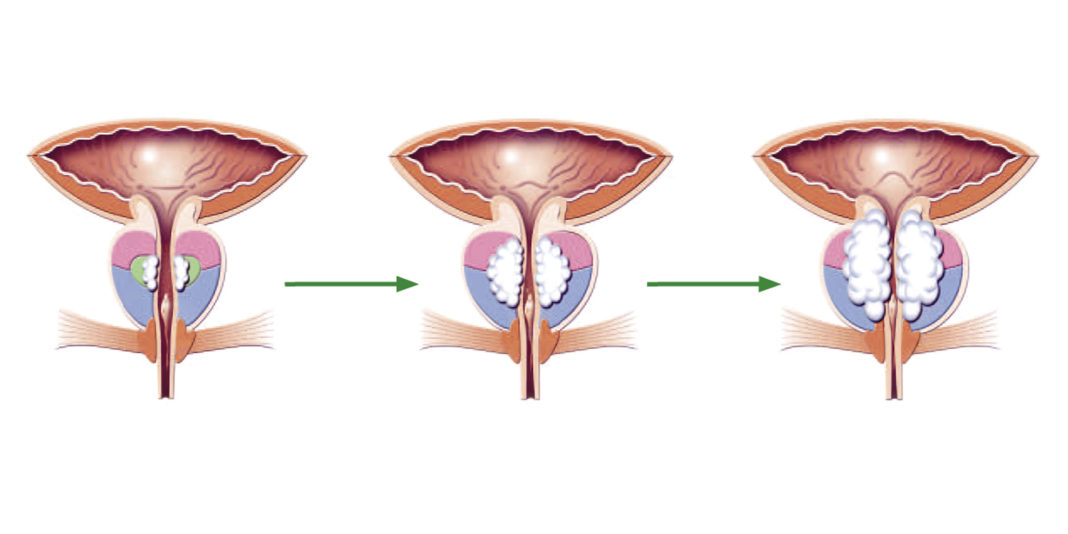A young man starts his adult life with a prostate gland about the size of a walnut. Around middle age it is common for the prostate to start gradually growing; in time it can reach the size of an orange or even a large grapefruit.
For the vast majority of men, the cause of this growth will be benign prostatic hyperplasia (BPH), so-called as the tissue growing in the gland is not cancerous. The location of the prostate though – lying just below the bladder and surrounding the urethra tube that delivers urine and semen down the penis – means a prostate the size of an orange can cause worrisome waterworks problems.
But not all men are bothered by their ageing and growing prostate, says Tauranga urologist Professor Peter Gilling. Even though more than 80 per cent of men in their 80s will have an enlarged prostate (BPH), the prevalence of lower urinary tract symptoms (LUTS) or ‘waterworks’ issues in men in that age group is only about 30 per cent. Over half of men aged over 50 will have BPH, but much fewer are worried by urinary problems.
Some men who come to see Gilling aren’t bothered by their waterworks symptoms per se but are worried that getting up several times a night to pee, or a slowed urine flow, might reflect something more sinister.
“Once we can reassure them [that their prostate is enlarged due to benign tissue growth, not a malignant prostate cancer] they say, ‘I’m quite happy Doc, see you later’ and don’t take things any further,” says Gilling.
For others though, the pressure of the enlarged prostate – a gland that exists to secrete the milky fluid part of semen – can cause distressing and bothersome symptoms.
In 2014 Gilling was named one of the world’s top experts in BPH research and treatment. He is based in Tauranga, where he heads the University of Auckland’s Bay of Plenty clinical campus and the district health board’s clinical trials unit. In the 1990s, with partner Mark Fraundorfer, he developed a laser treatment for removing prostate tissue known as HoLEP (holmium laser enucleation of the prostate), which is now practised throughout the world.
Many men will manage their BPH symptoms with lifestyle changes and medication, but about 25 per cent of men will go on to have surgery to reduce an enlarged prostate obstructing urinary flow.
Struggling to pee – irritation and obstruction symptoms
How bothersome and troublesome the symptoms are, rather than the size of the prostate, is the main driver of what treatment is offered for BPH, says Gilling.
Most men with BPH will first present to their general practice with lower urinary tract symptoms (LUTS), with the most common being slow urine flow, but others include needing to pee more often, a sense of urgency and not being able to ‘hold on’, dribbling urine and nocturia (frequent night-time peeing).
An initial assessment by a general practitioner or nurse practitioner is likely to include: checking a patient’s medical history and current medication for possible causes; assessing the severity of physical and other symptoms by using the International Prostate Symptom Score (IPSS) and a quality of life (QOL) questionnaire; checking for infection or blood in urine; carrying out a physical examination, including digital rectal examination to check for abnormalities; and discussing prostate specific antigen (PSA) testing for signs of prostate cancer based on their age and family history.
Gilling says the digital rectal exam (DRE) can only detect quite extensive disease and the “finger does not cut it” in accurately determining the prostate size but is still a useful test for detecting aspects of bowel function, the lower rectum and discovering some bowel cancers.
For most men, the cause of the LUTS will be found to be BPH, but Gilling says in some cases further tests will find that the men have normal size prostates and excellent urine flow and their symptoms could be due to other reasons, including an overactive bladder (OAB), which is also a common cause of LUTS for women.
For men whose LUTS are caused by an enlarged prostate, the nature of their symptoms – whether they mainly have ‘irritative’ symptoms like frequency and urgency to pee or ‘obstructive’ symptoms like restricted flow and difficulties peeing – will influence what treatment options they are offered and when.
Lifestyle and medical management of BPH
The first response for bothersome but not severe LUTS due to an enlarged prostate (BPH) are usually lifestyle modifications. These may include reviewing fluid intake, including types of fluids consumed that may potentially irritate the bladder (like caffeine and alcohol), and limiting fluids after the man’s evening meal. Men are encouraged to empty their bladders completely – particularly at night – with peeing twice and/or sitting to pee being options to consider. Men could also be asked to do a bladder or voiding diary to record how often and when they are peeing. This could be supported with pelvic floor exercises and bladder retraining to help with frequency and urgency issues.
Since the 1990s a range of drug options have been available for medical management of the symptoms of an enlarged prostate.
Gilling says the most common drug group used are alpha blockers, such as terazosin and doxazosin, which act on the sensitivity of the prostate and bladder. Although they have little impact on flow improvement, many men experience a significant reduction in symptoms.
Another drug group acts primarily on the bladder and can reduce the urge incontinence symptoms; another group of drugs, including finasteride, can improve symptoms by shrinking the prostate a little but can take three to six months to kick in; and a fourth group of drugs known to relieve the BPH symptoms are PDE5 inhibitors, such as Cialis and Viagra, which can be options for men who also have erectile dysfunction issues.
There is definitely a link between LUTS and erectile dysfunction, says Gilling, but it is not as simple as cause and effect.
“There’s no question that your sex life improves when you’ve got your waterworks symptoms sorted out, which is really common sense,” says Gilling, “particularly if men have previously been up and down to the toilet all night and irritated by their urinary tract.
“Some men describe a definite improvement in getting an erection after you treat their LUTS with surgery or drugs.”
But there is also a strong relationship between cardiovascular disease (CVD) and metabolic syndrome with erectile dysfunction, says Gilling, so, for example, men who start statins can find that not only do their CVD symptoms improve but also their waterworks are better and their erectile function improves.
Specialist assessment and surgical options
Lifestyle modifications and drugs will be enough to manage and control the lower urinary tract symptoms of BPH for many men, but for others it will not and these men – along with those whose initial presenting symptoms were already severe – will be referred for specialist assessments.
In the lead-up to or during their specialist assessment, if they haven’t already had them, men will have a blood test to check for kidney function, urine flow rate test, a urinary ultrasound (to check out the kidneys, the bladder full and empty and the size of the prostate), a further physical examination and routinely a PSA test.
Gilling says if the IPSS result is severe or moderately severe and there are no signs of cancer then it is nearly inevitable that an ultrasound will find that the prostate is two or three times the normal size and the flow rate is very slow.
Men with BPH that is affecting their kidney function, or have ongoing bleeding when they pee, or recurring, regular urinary tract infections, or bladder stones are high-priority candidates for surgery.
But not everybody with LUTS symptoms is a good candidate for surgery, says Gilling.
“You’ve got to make sure you are operating on people for the right reasons.”
Men with physical blockages and obstruction symptoms that are severely impacting on their quality of life are likely to get symptoms relief from reducing their prostates. But men whose main issue is a bladder problem may get little relief.
Surgery can change lives
Surgery ‘down there’ is not something men enter into lightly, but technology has come a long, long way since the first serious attempts in the late 19th century to use surgery to resolve this male malady.
During the last century, surgeons developed and refined the still most commonly used surgical treatment for BPH around the world, which is the TURP (transurethral resection of the prostate). A TURP involves inserting a thin tube-like telescope through the tip of the penis and up the urethra into the prostate gland. The surgeon then inserts a heated wire cautery loop up the tube to cut away excess tissue and seal the blood vessels at the same time.
Gilling says some poorly undertaken studies in the past saw TURP unfairly given a reputation for causing erectile problems in about 10 per cent of men. But when follow-up research was done to assess similarly aged men’s erectile function before and after TURP or hernia repair surgery, he says it was actually found that erectile score tests improved for most men after TURP.
“TURP is a very safe procedure and for most men – if the prostate is not too large – it can just change people’s lives,” says Gilling.
Bleeding can remain an issue with TURP for some men (2–3 per cent) and a TURP is not suitable for men with an enlarged prostate of over 80g. This led to the development of a range of laser treatments, including HoLEP.
“When you get above 100g [of prostate tissue], which is basically five times the normal size, then TURP becomes a bit unsafe and the laser procedures become a lot safer.”
Gilling says one impact of introducing drug treatments is that patients’ symptoms are being better managed for longer, so when they do present for surgery their prostates can be much larger than in the past.
“In the old days – in the 70s or 80s – if you did a TURP, the average amount of tissue they removed was around 15g.” He said the average now was two or three times that amount.
There are a raft of new surgical treatments for BPH – some with more long-term effectiveness than others – and what is available in the public health system depends on the local expertise.
“The laser procedures are enhancements, but TURP is still the workhorse.”
Source: Health Central
























